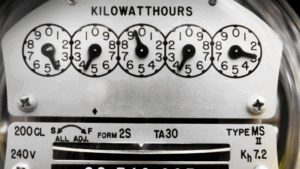 Understanding how to read your meter is an essential skill for any homeowner concerned about energy prices and energy consumption. Utility companies generally read your meter every 30-60 days. This means that some months they estimate energy usage based on previous readings, then adjust your bill if there is a difference between your projected usage and actual usage. However, you don’t need to rely on your power company to track energy consumption. With the right knowledge, you can do it yourself in only a few minutes.
Understanding how to read your meter is an essential skill for any homeowner concerned about energy prices and energy consumption. Utility companies generally read your meter every 30-60 days. This means that some months they estimate energy usage based on previous readings, then adjust your bill if there is a difference between your projected usage and actual usage. However, you don’t need to rely on your power company to track energy consumption. With the right knowledge, you can do it yourself in only a few minutes.
Where is Your Meter?
Most gas and electric meters are located on the exterior of your house, normally affixed to the back or side walls. Electric meters can usually be found near the spot where the power lines enter your home. For convenience, gas meters are commonly installed nearby, often in a meter box or cabinet for their protection. If your meter isn’t located outside, check your basement, garage, or utility room.
Utilities install meters outside for convenience, so workers can read them without accessing your house. However, with the introduction of smart meters, which can be monitored remotely, indoor meters are becoming more common. Though still not the standard, they are an increasingly popular feature in houses constructed after 2009.
Types of Meters
There are two types of meters: dial and digital. Most homes are equipped with dial meters, which track energy consumption with a set of spinning wheels. However, if you own a newer home, there’s a good chance you have a digital meter instead. Digital meters display your energy data on an LCD screen, so they can be read at a glance, without any special knowledge. Reading a dial meter is a little more complicated, but still only takes a few minutes.
How to Read a Dial Meter
Reading a gas or electric meter is simple. The dials are arranged left to right, each one representing a larger number of units. Electric meters normally start at 10,000 kilowatt hours (kWh), with the next one representing 1,000 kWh, then 100, 10, and finally one. Gas meters normally start at a million cubic feet and work their way down to 100,000, 10,000, and 1,000 with each subsequent dial.
Due to their unique gearing system, each dial moves in the opposite direction of the one next to it. If the one on the left moves clockwise, then the one to the right moves counterclockwise while the one next to it moves clockwise, and so on.
To read your meter, write down the numbers from right to left. If the pointer is between two numbers, the rule is to read the smaller one. When it’s between nine and zero, the zero represents ten, so nine is the lower number. If the pointer is directly on a number, only count it if the dial to the right of it has passed zero. Otherwise, read the lower number.
To determine how much energy you’ve used, subtract last month’s number from this month’s number. You can even record the number every week or every day, for a more in-depth look at your usage patterns.
What Are the Benefits of Reading Your Meter?
Reading your meter every day is probably a bit excessive, but keeping an eye on your gas and electricity consumption provides a clear picture of your home’s energy profile, enabling you to:
- Verify Bills. Despite their training, meter readers have been known to make mistakes. Reading your meter every month ensures you’re not being overcharged. It also gives you valuable evidence in case you need to dispute a mistake.
- Detect Leaks. An unusually high reading may indicate that your gas line has sprung a leak or one of your appliances is malfunctioning, drawing more power than it was designed to handle.
- Budget Effectively. Understanding your energy habits helps you predict future bills. By tracking surges in energy use, it can even tell you when it’s time to upgrade your wiring and HVAC system.
Save on Energy Related Repairs with Agway
Knowing how to read your meter helps you track your energy consumption, offering important feedback on your efforts to control costs. But while monitoring usage helps you manage your energy bills month to month, partnering with an independent energy supplier like Agway helps you control them long-term.
Agway Energy Services® doesn’t just power your home, we protect it. Our EnergyGuard program covers your heating, cooling, and electrical systems from damage caused by wear and tear. Home insurance doesn’t pay for these types of issues, but we do ‒ providing every customer with reliable support for their furnace or boiler, central air conditioner, and internal wiring.
When the need for repair occurs, our customers don’t have to waste time searching for a qualified technician. They contact us instead. Our service team maintains a network of certified contractors and electricians. As soon as we receive your message, we send the first available one straight to your door. There are no service fees or deductibles either. We pay for the visit and all covered parts. Don’t let a sudden breakdown upset your finances. Sign up and start enjoying the benefits of Agway EnergyGuard® today!